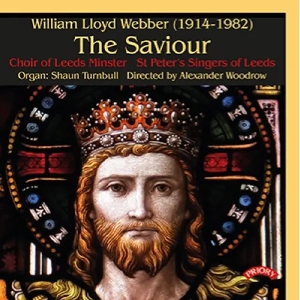
William Lloyd Webber (1914-1982)
The Saviour
Shaun Turnbull (organ)
Choir of Leeds Minster/Alexander Woodrow
rec. 2024, Leeds Minster, Leeds, UK
Priory PRCD1252 [73]
Over the years, there has been a steady trickle of recordings of William Lloyd Webber’s music. Most significant was the 1998 conspectus of choral and orchestral works on Chandos (CHAN 9595). Other discs have majored on organ pieces, choral music and songs. This release introduces the listener to several unrecorded organ preludes, a selection of anthems, and a modern recording of the large-scale cantata The Saviour. See my essay for more on the composer and his achievement.
The programme begins with three well-wrought anthems. Sing, O heavens is “suitable for harvest thanksgiving”; unusually, the SAB scoring omits the tenors. The opening and closing passages of this stirring anthem sound like Elgar or perhaps even Parry. The reflective O for a closer walk with God sets William Cowper’s well-known text. It considers the soul’s desire to be near God but also acknowledges its tendency to stray; this dichotomy is reflected in the ternary structure. The liner notes suggest Herbert Howells and Herbert Sumsion as stylistic indicators. Oh, Lord spread Thy wings oe’r me is set as a song for solo voice and organ. An unnamed mezzo-soprano sings tenderly.
Six Interludes on Passion Hymns are a satisfying contrast in this largely vocal programme. There is a green hill far away nods towards Percy Whitlock with its gentle “questioning and improvisatory” feel. When I survey the wondrous Cross introduces an insouciant right-hand accompaniment in 6/8 time against the hymn tune in the left hand. Ride on in Majesty is appropriately powerful in its commemoration of Jesus’ triumphant entry into Jerusalem on a donkey. The next two Interludes are pensive in mood as befits the sentiment of O come and mourn with me awhile and O sacred head sore wounded. Praise to the holiest in the height is an impressive toccata with a “blazing conclusion”. I feel that at a recital the Interludes benefit from being played as a set. In liturgical settings, they would make splendid individual voluntaries.
The liner notes give the background to the large-scale cantata The Saviour, designed as a Passiontide work in the tradition of John Stainer’s Crucifixion and John Henry Maunder’s Olivet to Calvary. It was dedicated to the Revd. Derrick Greeves and the Choir of Westminster Central Hall. Its full title offers an insight into the cantata’s ethos: A meditation upon the death of Christ. The libretto, compiled by Bryn Rees, contains passages from the Gospels and some hymns, as well as his own poetry.
Each of the work’s three parts portrays a unique aspect of Christ’s relationship to mankind: Man’s Need, God’s Remedy, and New Life in Christ. It includes choral passages, movements for soloists and recitatives. Notably, each part ends with a congregational hymn. I am not sure about the ultimate success of this piece. Yes, there are glorious moments in the proceedings, especially in the choral sections. But I found that too much recitative/declamation went to the (unnamed) tenor and bass soloists. What is not in doubt is the masterly performance by all concerned. This underscores the cantata’s distinctive musical language, defined by its rich, fluid melodies and opulent accompaniment. This evokes the style of Ralph Vaughan Williams, under whom Webber studied.
I understand that some of the music on this disc has not been previously recorded. There is a 1965 LP of The Saviour on the Pilgrim Records label (JLP125). Lloyd Webber conducted the Choir of Westminster Methodist Central Hall. Part III of The Saviour was issued in 1999 on Priory (PRCD 677). Harry Bramma conducted the Choir of All Saints, Margaret Street, London. I have not listened to these albums.
The choir of the Leeds Minster (formerly Leeds Parish Church) and organist Shaun Turnbull give a wonderful account of this repertorire.
Alexander Woodrow wrote the liner notes with the assistance of the late Simon Lindley. They provide a good introduction to this music. Dates of composition for the anthems and organ pieces would have been helpful. There are the texts of the anthems and The Saviour along with resumes of the choir and organist.
This excellent disc is essential to all lovers of English music from the choirstalls and the organ loft. This is another chapter in the reevaluation of William Lloyd Webber’s catalogue begun nearly thirty years ago.
John France
Contents
Sing, O Heavens (c.1957)
O for a closer walk with God (1957)
Oh, Lord spread Thy wings oe’r me. (1952)
Six Interludes on Passion Hymns: There is a green hill far away; When I survey the wondrous Cross; Ride on, ride on in Majesty; O come and mourn with me awhile; O sacred head sore wounded; Praise to the holiest in the height (1963)
Cantata: The Saviour (1961)
Buying this recording via a link below generates revenue for MWI, which helps the site remain free


















